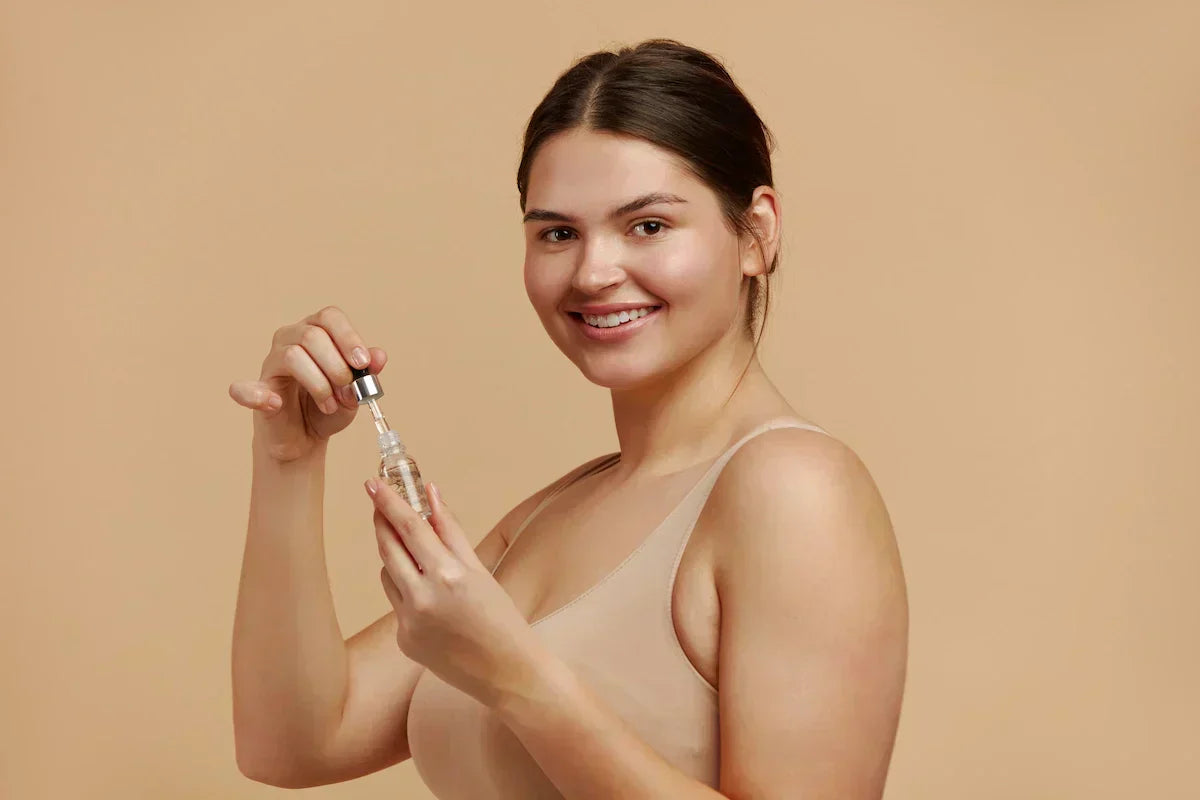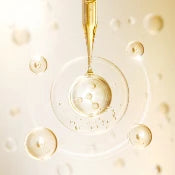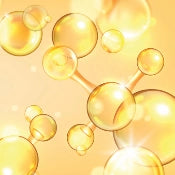In the ever-evolving world of skincare, alpha arbutin has emerged as a game-changing ingredient for those seeking a brighter, more even skin tone without the risks associated with traditional lightening agents. Alpha arbutin brightens skin tone by acting on melanin production, helping to even out hyperpigmentation and enhance overall radiance.
This powerful yet gentle compound has gained popularity for its ability to effectively target hyperpigmentation while maintaining an excellent safety profile across different skin types. Users find that visible results from using alpha arbutin can take several weeks to appear, emphasizing the importance of consistent application.
If you’re struggling with dark spots, melasma, or post-inflammatory hyperpigmentation, understanding alpha arbutin could be the key to achieving the clear, radiant complexion you desire. Alpha arbutin reduces dark spots, including age spots and acne scars, with a gentle, non-irritating approach that leads to visible improvement over time when used consistently.
This comprehensive guide will explore everything you need to know about this remarkable skin lightening agent, introducing alpha arbutin as a skin depigmenting agent and its important role in treating hyperpigmentation. The effectiveness of alpha arbutin in lightening skin may require consistent use over several weeks to see visible improvements.
What is Alpha Arbutin?
Alpha arbutin is a synthetic skin-lightening compound derived from the bearberry plant. It consists of hydroquinone bound to glucose, making it a glycoside derivative that offers the benefits of hydroquinone without the associated risks.
Unlike β arbutin, found naturally in plants like bearberry, cranberry, and blueberry, α arbutin is synthetically produced for enhanced stability and effectiveness. This molecular structure gives it unique properties, and it is estimated to be more than 10 times stronger than beta-arbutin.
- Chemical formula: C12H16O7
- Molar mass: 272.25 g/mol
- High water solubility, making it easily absorbed by the skin
- Greater stability when exposed to heat and light compared to natural forms
The production of synthetic forms of alpha arbutin typically involves enzymatic glycosylation processes using α-amylase and dextrin, or through recombinant bacterial systems like Escherichia coli with enzymes such as amylase from Bacillus subtilis and sucrose phosphorylase from Leuconostoc mesenteroides.
In cosmetic products, you might find it listed under various names, including:
- Alpha-arbutin
- 4-hydroxyphenyl-D-lucopyranoside
- Alpha-arbutoside
What sets alpha arbutin apart from other skin lightening ingredients is its gentle yet effective approach to addressing pigmentation without compromising cell viability or triggering inflammation.
How Alpha Arbutin Works?
Understanding how alpha arbutin works reveals why it’s become such a valuable tool in treating various forms of hyperpigmentation.
Tyrosinase Inhibition
The primary depigmenting mechanism of alpha arbutin involves inhibiting tyrosinase, the key enzyme responsible for melanin production. Melanin is the pigment that gives skin its color, and excess melanin leads to dark spots and uneven skin tone.
Unlike hydroquinone, which can be cytotoxic to melanocytes (the cells that produce melanin), alpha arbutin inhibits the process without destroying the cells themselves. It acts as a competitive inhibitor by:
- Mimicking the substrate of tyrosinase
- Binding to the enzyme’s active site
- Preventing the conversion of tyrosine to melanin
This gentle approach means that alpha arbutin works without the risk of permanent damage to melanocytes or rebound hyperpigmentation, often associated with more aggressive treatments.

Controlled Release Mechanism
One of the most ingenious aspects of alpha arbutin’s design is how it functions as a “pro-drug” of sorts:
- The hydroquinone portion is released slowly when applied to the skin
- This controlled release minimizes irritation and side effects
- The gradual action provides sustained benefits without overwhelming the skin
Antioxidant Properties
Beyond its primary role in inhibiting melanin synthesis, alpha arbutin also demonstrates significant antioxidant activity. This provides additional benefits by:
- Scavenging free radicals that can trigger inflammation and hyperpigmentation
- Reducing oxidative stress in skin cells
- Providing protection against environmental damage that can worsen pigmentation issues
This dual-action approach, targeting both existing hyperpigmentation and preventing new spots from forming, makes alpha arbutin particularly valuable in comprehensive skincare routines.
Benefits of Alpha Arbutin
Alpha arbutin offers multiple benefits that extend beyond simple skin lightening, making it a versatile addition to any skincare routine.
Reduces Various Forms of Hyperpigmentation
One of the most compelling reasons to use alpha arbutin is its effectiveness against multiple types of pigmentation issues:
- Dark spots and age spots: Target melanin clusters caused by sun exposure or aging
- Melasma: Helps fade the stubborn patchy hyperpigmentation often triggered by hormonal changes
- Post-inflammatory hyperpigmentation: Reduces dark marks left behind after acne or other skin trauma
- Freckles: Can help fade and lighten naturally occurring or sun-induced freckles
- Sun damage: Addresses uneven pigmentation caused by UV exposure
Suitable for All Skin Types
Unlike many other lightening agents that can cause irritation, alpha arbutin is remarkably well-tolerated:
- Safe for sensitive skin with minimal risk of irritation
- Appropriate for dry skin without causing further dehydration
- Non-comedogenic and suitable for acne-prone skin
- Effective across different skin tones from fair to deep
Additional Benefits Beyond Lightning
Alpha arbutin’s benefits go beyond just addressing hyperpigmentation:
- Improves overall skin tone: Creates a more even, radiant complexion
- Enhances skin clarity: Reduces dullness and promotes a clearer appearance
- Complements other treatments: Works well with treatments for acne scars and other skin concerns
- Provides antioxidant protection: Helps protect against environmental damage
Clinical evidence supports these benefits, with studies showing significant improvements in various hyperpigmentation disorders. In one notable study, a 10% concentration led to a 43.5% reduction in UV-induced hyperpigmentation, and when combined with aloesin, efficacy increased to 63.3% in melanin reduction.
Alpha Arbutin vs Other Lightening Ingredients
To truly appreciate alpha arbutin’s value, it helps to compare it with other popular skin lightening agents on the market.
Alpha Arbutin vs Beta Arbutin
Though closely related, these two forms have important differences:
|
Feature |
Alpha Arbutin |
Beta Arbutin |
|---|---|---|
|
Potency |
Up to 10x more potent |
Less potent |
|
Stability |
More stable in formulations |
Less stable, degrades faster |
|
Source |
Synthetically produced |
Naturally occurring in plants |
|
Effectiveness |
Works at lower concentrations |
Requires higher concentrations |
|
Cost |
Generally more expensive |
More affordable |
The enhanced stability and potency of alpha arbutin make it worth the higher price point for most users seeking meaningful results.
Alpha Arbutin vs Hydroquinone
Hydroquinone has long been considered the gold standard for treating hyperpigmentation, but it comes with significant drawbacks:
- Safety profile: Alpha arbutin has minimal side effects, while hydroquinone can cause ochronosis (bluish-black discoloration), irritation, and is banned in some regions, including the European Union
- Mechanism: Alpha arbutin inhibits melanin production, while hydroquinone can be cytotoxic to melanocytes
- Long-term use: Alpha arbutin is safe for extended use, while hydroquinone is typically limited to 3-month treatment periods
- Rebound effect: Hydroquinone can cause rebound hyperpigmentation when discontinued; alpha arbutin doesn’t have this effect
Alpha Arbutin vs Kojic Acid
Kojic acid is another popular tyrosinase inhibitor:
- Kojic acid tends to be more potent but also more irritating to sensitive skin
- Alpha arbutin offers better stability in formulations (kojic acid oxidizes quickly)
- Both can be effectively combined for enhanced results
- Alpha arbutin has better water solubility for improved absorption
Alpha Arbutin vs Vitamin C
Vitamin C (ascorbic acid) is a powerful brightening antioxidant that works well with alpha arbutin:
- Vitamin C works primarily through antioxidant activity, while alpha arbutin directly inhibits tyrosinase
- Vitamin C is more prone to oxidation and instability in formulations
- The combination of both ingredients creates synergistic effects for enhanced brightening
- Vitamin C has additional collagen-boosting benefits that complement alpha arbutin’s lightening effects
This comparison shows why many advanced formulations contain multiple brightening agents that work through different mechanisms for optimal results.
How to Use Alpha Arbutin
Maximizing alpha arbutin’s benefits requires understanding how to properly incorporate it into your skin care routine.

Recommended Concentrations
The effectiveness of alpha arbutin is concentration-dependent:
- Face creams and serums: Typically contain 1-2% alpha arbutin
- Body lotions: Usually formulated with around 0.5% concentration
- Spot treatments: May contain up to 2% for targeted treatment
Higher concentrations aren’t necessarily better—the 1-2% range has been shown to be effective without increasing the risk of irritation.
Application Guidelines
For best results, follow these application guidelines:
- Cleanse thoroughly: Apply to clean, dry skin
- Apply a small amount: A pea-sized amount is sufficient for the entire face
- Target specific areas: Can be used all over or as a spot treatment for dark spots
- Layer properly: Apply after toners but before heavier creams
- Use consistently: Apply once or twice daily for best results
- Be patient: Results typically appear after 4-8 weeks of consistent use
- Always use sunscreen: SPF 50 is essential when using any lightening product. When using arbutin, it is recommended to apply it to the whole face once or twice a day.
Complementary Ingredients
Alpha arbutin works exceptionally well with other active ingredients:
- Vitamin C: Enhances brightening effects and provides additional antioxidant protection
- Niacinamide: Improves barrier function and offers complementary brightening benefits
- Hyaluronic acid: Provides hydration to counteract any potential drying effects
- Gentle exfoliants: Ingredients like glycolic acid help enhance penetration and efficacy
Best Practices for Application
To maximize results:
- Start with a patch test to ensure you don’t have a rare sensitivity
- Begin with once-daily application before increasing to twice daily
- Apply to slightly damp skin to enhance absorption
- Be consistent—results require regular, ongoing use
- Protect your investment by storing products away from light and heat
- Don’t mix with alkaline products, as alpha arbutin is most stable at a slightly acidic pH
Skin Care Routine Integration
Where Alpha Arbutin Fits in Your Routine
Alpha arbutin is a versatile addition to any skin care routine, especially for those looking to brighten and even out their skin tone. For best results, incorporate alpha arbutin serums or creams after cleansing and toning, but before applying your moisturizer. This placement allows the active ingredient to penetrate effectively and deliver its skin-lightening effects.
If you have sensitive skin, start with a lower concentration of alpha arbutin and gradually increase as your skin builds tolerance. Alpha arbutin pairs well with other skin care ingredients, such as vitamin C, hyaluronic acid, and kojic acid, to create a powerful combination that enhances brightening and hydration while minimizing the risk of irritation. Consistent use, both morning and evening, is key to achieving a more radiant and even skin tone.
Layering with Other Products
When layering alpha arbutin with other skin care products, the order of application is crucial for maximizing benefits and minimizing skin irritation. Always apply alpha arbutin serums or creams after cleansing and toning, but before heavier moisturizers or oils. This ensures that arbutin is absorbed efficiently into the skin.
If you use exfoliating products, such as those containing AHAs or BHAs, apply them before alpha arbutin, but be mindful that combining too many actives can increase the risk of irritation, especially for sensitive skin. Start with a lower concentration of alpha arbutin and gradually increase as your skin adapts. By following these guidelines, you can safely integrate alpha arbutin into your skin care routine and enjoy its brightening effects without compromising skin health.
Morning vs Evening Use
Alpha arbutin is suitable for use both in the morning and evening, making it a flexible option in your daily skin care routine. In the morning, apply alpha arbutin serums or creams after cleansing and toning, followed by a moisturizer and a broad-spectrum sunscreen.
This helps protect your skin from further hyperpigmentation and sun-induced darkening, while supporting a brighter, more even skin tone throughout the day. In the evening, use alpha arbutin after cleansing and toning, and before your night cream or moisturizer. Overnight, alpha arbutin works to brighten and even out your skin tone, targeting hyperpigmentation as you sleep. Consistent use, paired with diligent sun protection, will help you achieve and maintain a radiant complexion.
Alpha Arbutin Side Effects and Safety
Despite its excellent safety profile, understanding potential alpha arbutin side effects and contraindications is essential for optimal results.
Potential Side Effects
Alpha arbutin is generally well-tolerated, but some users may experience:
- Mild skin irritation (uncommon)
- Temporary redness
- Slight dryness
- Sensitivity to sunlight
These reactions are typically mild and often resolve as the skin adjusts to the ingredient. If irritation persists, reducing the frequency of application or concentration can help.
Safety Considerations
The safety profile of alpha arbutin is significantly better than hydroquinone:
- No cytotoxicity to melanocytes
- No risk of ochronosis (blue-black discoloration)
- No evidence of systemic absorption or toxicity
- No rebound hyperpigmentation when discontinued
However, certain precautions should still be observed:
- Sunscreen is mandatory: Alpha arbutin makes skin more susceptible to UV damage
- Product stability matters: Choose products in opaque, airless packaging to prevent degradation
- Pregnancy and breastfeeding: Limited safety data exists, so caution is advised
- Patch testing: Always perform a patch test before full application, especially if you have sensitive skin
Who Should Avoid Alpha Arbutin
While safe for most people, certain individuals should exercise caution:
- Those with known allergies to hydroquinone or glucose derivatives
- Individuals with severely compromised skin barriers
- People with active rosacea flares
- Those using multiple other potentially irritating active ingredients
- Pregnant or breastfeeding women (due to limited safety data)
If you’re unsure, consulting with a dermatologist before beginning any new treatment for hyperpigmentation is always a wise choice.

Product Formulations and Delivery
Alpha arbutin is available in various cosmetic formulations designed to optimize its delivery and effectiveness.
Common Product Types
You’ll find alpha arbutin in several product formats:
- Serums: Highest concentrations (usually 1-2%) with lightweight textures for maximum penetration
- Creams: Medium concentrations with added moisturizing benefits
- Toners: Lower concentrations that prepare skin for other treatments
- Spot treatments: Targeted products with higher concentrations for specific dark spots
- Sheet masks: Intensive treatments that boost hydration alongside brightening effects
Advanced Delivery Technologies
Cosmetic formulations are increasingly using sophisticated delivery systems:
- Liposomal encapsulation: Improves stability and enhances penetration
- Nanoparticle formulations: Allows for deeper delivery into skin layers
- Cyclodextrin complexes: Enhance stability against heat and light degradation
- Microemulsions: Improves bioavailability and absorption
These advanced technologies help maximize the effectiveness of alpha arbutin while minimizing potential irritation.
Stability Considerations
The presence of alpha arbutin in a product requires careful formulation:
- pH-dependent stability: Most stable in slightly acidic formulations (pH 4.0-5.5)
- Packaging matters: Opaque, airless pumps protect from light and oxygen exposure
- Compatibility with other ingredients: Formulations must avoid ingredients that could destabilize alpha arbutin
- Temperature sensitivity: Should be stored away from heat sources, as excessive heat exposure can reduce the effectiveness of alpha arbutin in skincare formulations.
When shopping for products containing alpha arbutin, look for those from reputable manufacturers who understand these formulation challenges.
Clinical Evidence and Efficacy
The effectiveness of alpha arbutin is supported by robust clinical evidence.
Key Research Findings
Scientific studies demonstrate alpha arbutin’s efficacy:
- A 10% concentration led to a 43.5% reduction in UV-induced hyperpigmentation
- Combined with aloesin, efficacy increased to 63.3% in melanin reduction
- 2% deoxyarbutin (a related derivative) performed similarly to 4% hydroquinone in clinical studies
- Combination with Q-switched Nd:YAG laser showed 51% melasma improvement in 66.7% of patients
Cellular Studies
Research at the cellular level provides insight into how alpha arbutin works:
- Studies on cultured human melanoma cells show significant inhibition of tyrosinase activity
- Gene expression analysis confirms downregulation of melanin-producing pathways
- Cell viability remains excellent even at high concentrations, confirming safety
- Antioxidant properties have been verified through free radical scavenging assays
- These findings confirm that alpha arbutin not only works effectively but does so through well-understood mechanisms that maintain cell health.
Skin Care and Alpha Arbutin
Impact on Overall Skin Health
Alpha arbutin does more than just lighten dark spots—it actively supports overall skin health. By inhibiting tyrosinase, the enzyme responsible for melanin production, alpha arbutin helps prevent the formation of excess melanin, resulting in a more even skin tone and reducing the risk of hyperpigmentation.
Its antioxidant properties protect the skin from free radical damage, which can contribute to premature aging, fine lines, wrinkles, and age spots. Regular use of alpha arbutin not only brightens the appearance of your skin but also helps maintain a smoother, healthier, and more radiant complexion. This makes alpha arbutin an excellent choice for individuals seeking to enhance both the appearance and health of their skin.
Future Developments
The field of skin lightening continues to evolve, with alpha arbutin at the forefront of innovation.
Enhanced Derivatives
Researchers are developing next-generation compounds based on the alpha arbutin structure:
- Deoxyarbutin: Shows enhanced stability and efficacy
- Calixarbutin: Novel derivatives with improved penetration
- Modified release systems: Allowing for less frequent application with sustained results
Advanced Combination Therapies
The future of hyperpigmentation treatment likely involves sophisticated combinations:
- Personalized formulations based on specific hyperpigmentation types
- Multi-target approaches addressing different aspects of the melanin formation pathway
- Integration with energy-based treatments like lasers and light therapy
- AI-driven formulation technology to optimize ingredient combinations
As our understanding of skin biology advances, alpha arbutin will likely remain a cornerstone ingredient while these new approaches continue to evolve.
Conclusion
Alpha arbutin stands as one of the most valuable innovations in the treatment of hyperpigmentation disorders. Its unique balance of effectiveness and safety makes it appropriate for virtually all skin types, addressing everything from stubborn melasma to post-acne dark marks.
Unlike harsher alternatives like hydroquinone, alpha arbutin offers a gentle yet effective approach to skin brightening that works in harmony with your skin’s natural processes, rather than disrupting them. The scientific evidence supporting its use continues to grow, confirming what many users have already discovered through personal experience.
Whether you’re dealing with sun damage, age spots, or the aftermath of skin inflammation, incorporating alpha arbutin into your skin care routine offers a science-backed solution that delivers visible results without compromising skin health.
When shopping for alpha arbutin products, look for stable formulations with complementary ingredients like vitamin C or niacinamide to maximize your results, and always remember that consistency, sun protection, and patience are key to achieving the even, radiant skin tone you desire.
Frequently Asked Questions (FAQ)
What Alpha Arbutin ingredient options does Flychem supply for skincare formulations?
Flychem offers high-quality Alpha Arbutin through our specialized Casporil™ (Alpha Arbutin 99%), renowned for its exceptional purity and effectiveness.
Can Flychem confirm if Casporil™ (Alpha Arbutin 99%) is Vegan-certified?
Yes, our Casporil™ (Alpha Arbutin 99%) is Certified Vegan, aligning perfectly with cruelty-free and sustainable formulation standards.
Does Flychem provide regulatory documentation for Casporil™ (Alpha Arbutin 99%)?
Absolutely. Flychem provides comprehensive documentation, including Certificates of Analysis (COA), Technical Data Sheets (TDS), Material Safety Data Sheets (MSDS), and necessary compliance support.
What is the typical lead time for dispatching Alpha Arbutin orders from Flychem?
Flychem guarantees prompt dispatch, typically within 24 to 48 hours after order confirmation, to support your production schedules.
Does Flychem enforce any MOQ requirements for ordering Alpha Arbutin?
No, we maintain a highly flexible ordering policy without any strict MOQ. You can order customized quantities as per your formulation requirements.
Can customers request customized samples of Alpha Arbutin for formulation evaluation?
Certainly! Flychem offers customized sample quantities of Casporil™ (Alpha Arbutin 99%) to facilitate comprehensive testing and formulation development.













